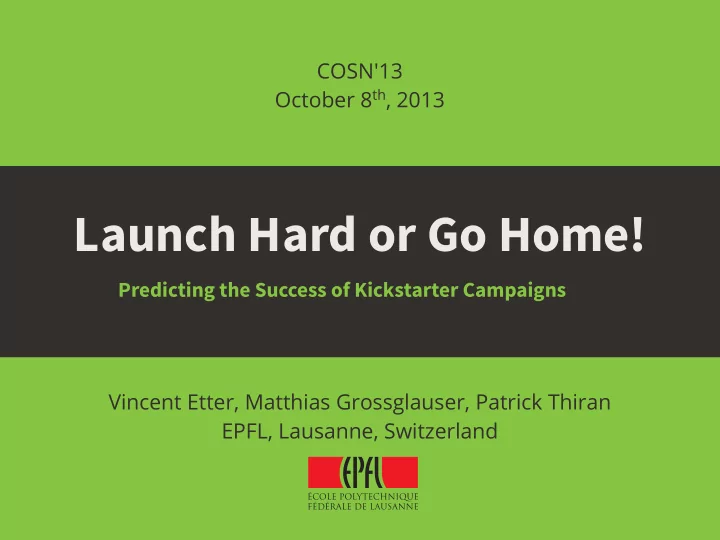

COSN'13 October 8 th , 2013 Launch Hard or Go Home! Predicting the Success of Kickstarter Campaigns Vincent Etter, Matthias Grossglauser, Patrick Thiran EPFL, Lausanne, Switzerland
What is Kickstarter? • Crowdfunding website • Raise money to launch creative projects • Each campaign has: • a funding goal • a campaign duration • All-or-nothing funding model 2
A Success Story • Since its launch in 2009: • 50,000 projects successfully funded • 44% success rate • $811,000,000 raised • 4,900,000 backers 3
Our Dataset • Discover campaigns on the "Recently Launched" page • Regularly get their status : number of backers, amount of money pledged • Monitor Twitter in parallel for all tweets containing keyword kickstarter 4
Our Dataset • From September 2012 to May 2013: • 16,042 campaigns • 48.24% of successful campaigns • 1,309,295 backers • $158,026,656 pledged • 737,398 "kickstarter" tweets 5
Our Predictors • Baseline : campaigns' static attributes [1] • Two sources of information: • Money : kNN, Markov • Social : tweets, project/backer graph [1] M. Greenberg et al. Crowdfunding support tools: predicting success & failure . In CHI'13 Extended Abstracts. ACM, 2013. 6
Graph Predictor • Can we use backers as source of information? • Consider the project/backer graph: 2 1 7
Graph Predictor • Extract several features: • # of backers • #/prop. of fi rst-time backers • # projects with co-backers 2 1 • #/prop. of these that are successful • Train a Support Vector Machine 8
Prediction Accuracy kNN Markov Graph Tweets Baseline 9
Combined Predictor • Money-based results are quite good • Can we use social predictors to help ? • Train a SVM to combine individual predictions 10
Combiner Results 11
Conclusion • Combiner improves early predictions • There is potential in social predictors • Future work: • Improve graph predictor • Take dynamics on Twitter and project/backer graph into account 12
Thank you! Data and real-time predictions on http://sidekick.ep fl .ch 13
Recommend
More recommend